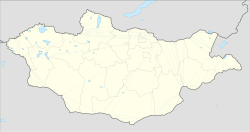Ordu-Baliq
This article needs additional citations for verification. (June 2011) |
 The west gate as seen from the citadel | |
| Location | Mongolia |
|---|---|
| Coordinates | 47°25′52″N 102°39′34″E / 47.431111°N 102.659444°E |
Ordu-Baliq
Location
Ordu-Baliq is in a grassy plain called the Talal-khain-dala steppe, on the western bank of the
A favorable micro-climate makes the location ideal for pasturage, and it lies along the most important east-west route across Mongolia. As a result, the Orkhon Valley was a center of habitation and important political and economic activity long before the birth of Genghis Khan, who made it known to the wider world.
History
In 744, after the defeat of the last
The capital occupied at least 32 square kilometers.
The urban area has three main parts. The largest and central part consists of numerous buildings surrounded by a continuous wall. Ruins of a large number of
Ordu Baliq was a fully fortified commandry and commercial entrepot typical of the central points along the length of the Silk Road. The well-preserved remains now consist of concentric fortified walls and lookout towers, stables, military and commercial stores, and administrative buildings. There are remains of a water drainage system. Archaeologists established that certain areas were allotted for trade and handcrafts, while in the center of the town were palaces and temples, including a monastery. The palace had fortified walls around it and two main gates, east and west, as well as moats filled with water and watchtowers.
The architectural style and planning of the city appear to have close parallels with T'ang Chinese models, although some elements appear to have derived inspiration from elsewhere.[3]
Historical accounts

An ambassador from the Samanid Empire, Tamim ibn Bahr, visited Ordu Baliq in 821 AD and left the only written account of the city. He traveled through uninhabited steppes until he arrived at the Uighur capital. He described Ordu-Baliq as a great town, "rich in agriculture and surrounded by rustaqs (villages) full of cultivation lying close together. The town had twelve iron gates of huge size. The town was populous and thickly crowded and had markets and various trades."[4] He reported that amongst the townspeople, Manichaeism prevailed.
The most striking detail of his description is the golden yurt or tent on top of the citadel where the khagan held court.[5]
He says that from (a distance of) five
farsakhs before he arrived in the town (of the khaqan) he caught sight of a tent belonging to the king, (made) of gold. (It stands) on the flat top (sath) of his castle and can hold (tasa') 100 men.— Tamim b. Bahr al-Muttawwi'i, translation by Minorsky[5]
The golden tent was considered the heart of the Uyghur power, gold being the symbol of imperial rule.[6] The presence of a golden tent is confirmed in Chinese historical accounts where the Kirghiz khan was said to have vowed to seize the Uyghurs' golden tent.[7]
Discovery
In 1871, the
The site was identified as a ruined Uyghur capital by the expedition of
See also
- Architecture of Mongolia
- Khara-Khoto
- Por-Bazhyn, a ruined structure on a lake island high in the mountains of southern Tuva, whose lay-out is similar to the palace complex of Karabalgasun
Footnotes
- ^ also spelled Ordu Balykh, Ordu Balik, Ordu-Balïq, Ordu Balig, Ordu Baligh
References
- ^ Hüttel, Hans-Georg, Ulambayar, Erdenebat (2009). Karabalgasun und Karakorum - Zwei spätnomadische Stadtsiedlungen im Orchon-Tal (in German and Mongolian). Ulaanbaatar. p. 18.
{{cite book}}: CS1 maint: location missing publisher (link) CS1 maint: multiple names: authors list (link) - ^ "Selenge Stone Inscription", known also as "Moghon Shine Usu Inscription" or "Monument of Moyunchur (Bayanchur)" in Orkhon Uyghur runic script, composed in 759 CE on a granite stele, line 34
- ^ Arden-Wong, L.A. (2012) "The architectural relationship between Tang and Eastern Uighur Imperial Cities", in Zs. Rajkai and I. Bellér-Hann (eds.) Frontiers and Boundaries: Encounters on China's Margins. Asiatische Forschungen 156, Wiesbaden: Harrassowitz Verlag, pp. 11–47.
- ISBN 978-81-208-1595-7. Retrieved 15 March 2012.
- ^ S2CID 129368313.
- ISBN 978-0-7081-0457-6.
- Xin TangshuChapter 217 part 2. Original text: 挐鬥二十年不解。阿熱恃勝,乃肆詈曰:「爾運盡矣!我將收爾金帳,於爾帳前馳我馬,植我旗,爾能抗,亟來,即不能,當疾去。」 Translation: The struggle went on for twenty years without resolution. Trusting that he will be victorious, (the Kirghiz khan) A-re thus boldly cursed: "Your fate is sealed! I will seize your golden tent, and in front of your tent my horses will gallop and my banners will be planted. If you can resist, come right now, but if you cannot, then you'd be quickly gone."
Further reading
- Minorsky, V. (1948). "Tamīm ibn Baḥr's Journey to the Uyghurs". Bulletin of the School of Oriental and African Studies. 12 (2). Cambridge: Cambridge University Press: 275–305. S2CID 129368313.
- Drompp, Michael Robert (2005). Tang China and the Collapse of the Uighur Empire: A Documentary History. Brill. p. 366. ISBN 978-90-04-14129-2.
External links
- Glazier, James (2005-09-24). "Khar Balgasyn Tuur - Ruins of Uigher Capital (8th Century)". Indiana University. Archived from the original on 16 October 2005.


